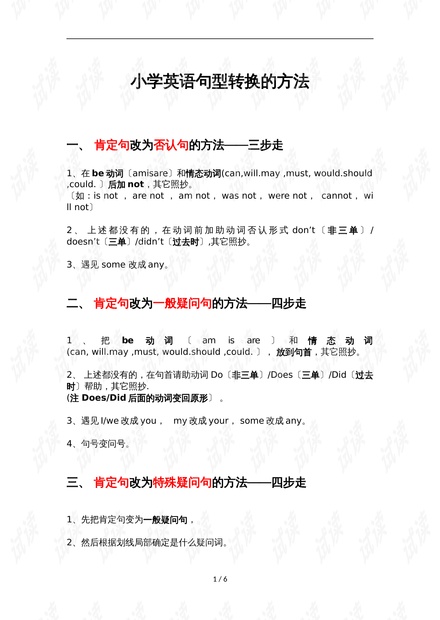小学英语中的句型转换是学习英语语法的重要组成部分,它涵盖了肯定句、否定句、一般疑问句和特殊疑问句之间的变化。下面将详细讲解这些转换方法,并给出实例。
我们来看肯定句改为否定句的规则:
1. 如果句中有be动词(am, is, are)或情态动词(can, will, may, must等),只需在其后加上not,其余部分保持不变。例如:“I am listening to music.” 变为 “I am not listening to music.”
2. 如果没有be动词或情态动词,需要在动词前添加助动词do(非三单)、does(三单)或did(过去时)的否定形式,并将动词恢复原形。例如:“Mike is a student.” 变为 “Mike is not a student.”
3. 当遇到some时,应改为any。如:“There are some flowers in the vase.” 变为 “There are not any flowers in the vase。”
接下来,转换肯定句为一般疑问句的步骤:
1. 将be动词或情态动词移到句首。例如:“Sarah can clean the classroom.” 变为 “Can Sarah clean the classroom?”
2. 如果没有be动词或情态动词,使用助动词do(非三单)、does(三单)或did(过去时)提问,动词变回原形。例如:“We need some masks.” 变为 “Do we need some masks?”
3. 将第一人称I/we改为you,my改为your,some改为any。例如:“This is my sister.” 变为 “Is this your sister?”
4. 句尾句号改为问号。
对于肯定句转化为特殊疑问句的步骤:
1. 先将其变为一般疑问句。
2. 确定疑问词。常见的特殊疑问词有what(什么)、how(怎样)、who(谁)、which(哪一个)、why(为什么)、where(哪里)、how many(多少)、how much(多少钱)、what colour(什么颜色)、how old(多大)、when(什么时候)等。例如,如果要问“Sarah can clean the classroom.”中的动作,疑问词可能是“what”或“how”。
3. 将疑问词置于一般疑问句前,删去划线部分。
4. 句号变问号。
现在我们应用这些规则进行实际的句型转换:
否定句:
1. I am not listening to music.
2. Mike is not a student.
3. Sarah cannot clean the classroom.
4. They are not in the zoo.
5. There are not any flowers in the vase.
6. This is not my sister.
7. We are not sweeping the floor.
一般疑问句:
1. Are you listening to music?
2. Is Mike a student?
3. Can Sarah clean the classroom?
4. Are they in the zoo?
5. Are there any flowers in the vase?
6. Is this your sister?
7. Are we sweeping the floor?
在小学英语教学中,掌握这些句型转换的技巧对提高学生的语言运用能力至关重要,同时也为他们的进一步英语学习打下坚实基础。通过反复练习,孩子们可以熟练掌握这些转换,提升自己的英语水平。



















